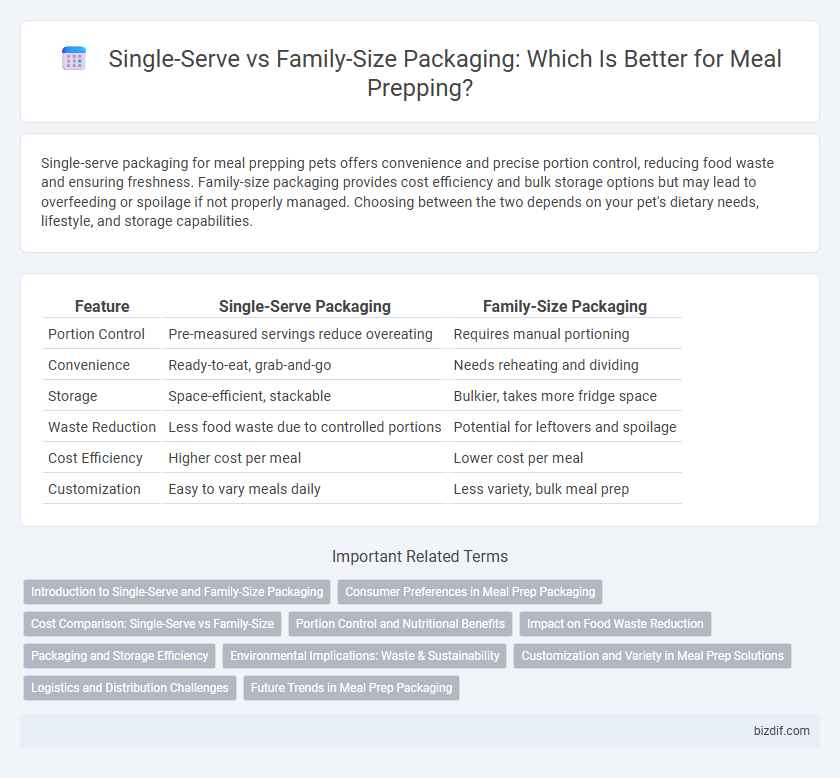Single-serve packaging for meal prepping pets offers convenience and precise portion control, reducing food waste and ensuring freshness. Family-size packaging provides cost efficiency and bulk storage options but may lead to overfeeding or spoilage if not properly managed. Choosing between the two depends on your pet's dietary needs, lifestyle, and storage capabilities.
Table of Comparison
| Feature | Single-Serve Packaging | Family-Size Packaging |
|---|---|---|
| Portion Control | Pre-measured servings reduce overeating | Requires manual portioning |
| Convenience | Ready-to-eat, grab-and-go | Needs reheating and dividing |
| Storage | Space-efficient, stackable | Bulkier, takes more fridge space |
| Waste Reduction | Less food waste due to controlled portions | Potential for leftovers and spoilage |
| Cost Efficiency | Higher cost per meal | Lower cost per meal |
| Customization | Easy to vary meals daily | Less variety, bulk meal prep |
Introduction to Single-Serve and Family-Size Packaging
Single-serve packaging offers portion-controlled meals ideal for individuals seeking convenience and reduced food waste, featuring pre-portioned containers that simplify meal prep and storage. Family-size packaging caters to larger households or group dining, providing bulk quantities designed for shared consumption, optimizing cost efficiency and minimizing frequent repurchasing. Both packaging options support meal prepping by addressing distinct needs in portion control, storage, and convenience.
Consumer Preferences in Meal Prep Packaging
Consumers prefer single-serve packaging in meal prepping for its convenience, portion control, and reduced food waste, aligning with busy lifestyles and health-conscious goals. Family-size packaging appeals to cost-effectiveness and bulk preparation but often leads to challenges in storage and portion management. Meal prep brands increasingly offer diverse packaging options to cater to individualized needs and enhance user experience.
Cost Comparison: Single-Serve vs Family-Size
Family-size packaging typically offers a lower cost per serving, making it more economical for bulk meal prepping and larger households. Single-serve packaging incurs higher expenses due to increased packaging materials and convenience factors, which may outweigh the benefits for frequent meal preparation. Evaluating cost comparison involves balancing upfront savings with potential food waste from larger portions in family-size packs.
Portion Control and Nutritional Benefits
Single-serve packaging enhances portion control by providing precise meal sizes that help manage calorie intake and reduce overeating risks. Family-size packaging often leads to larger, less controlled portions, which may contribute to inconsistent nutritional consumption. Choosing single-serve options supports consistent nutrient balance and aids in maintaining dietary goals effectively.
Impact on Food Waste Reduction
Single-serve packaging significantly reduces food waste by allowing precise portion control, minimizing leftover ingredients and uneaten meals. Family-size packaging often leads to surplus food that spoils before consumption, increasing overall waste. Choosing single-serve options supports sustainable meal prepping by aligning portions with individual consumption patterns.
Packaging and Storage Efficiency
Single-serve packaging enhances portion control and reduces food waste by providing pre-measured meals, which simplifies storage in compact spaces like mini-fridges or lunchboxes. Family-size packaging offers bulk storage benefits but often requires additional containers, leading to inefficient use of refrigerator or pantry space. Optimizing packaging size based on household size and consumption patterns improves overall storage efficiency and meal freshness.
Environmental Implications: Waste & Sustainability
Single-serve packaging in meal prepping generates significantly more plastic waste due to individual wrappers and containers, contributing to environmental pollution and landfill overflow. Family-size packaging reduces the amount of packaging material per meal, promoting better resource efficiency and lower carbon footprint. Choosing bulk packaging options supports sustainability by minimizing packaging waste and encouraging the reuse or recycling of containers.
Customization and Variety in Meal Prep Solutions
Single-serve packaging in meal prepping offers precise portion control and allows for easy customization of meals to individual dietary needs or taste preferences. Family-size packaging supports bulk preparation, providing cost-effective solutions but limits variety due to uniform meal options. Balancing single-serve and family-size packaging enhances flexibility, enabling diverse meal plans while optimizing convenience and portion accuracy.
Logistics and Distribution Challenges
Single-serve packaging requires more complex logistics due to increased packaging volume and higher demand for precise inventory management, leading to greater transportation costs and storage space requirements. Family-size packaging reduces packaging waste and allows for bulk shipping, but poses challenges in last-mile distribution where consumer demand favors smaller, convenient portions. Efficient route planning and warehouse optimization are critical to balance the differing distribution needs of single-serve versus family-size meal prep products.
Future Trends in Meal Prep Packaging
Future trends in meal prep packaging emphasize sustainability and convenience, with single-serve packaging gaining popularity for its portion control and reduced food waste. Innovations include biodegradable materials and smart packaging that monitors freshness, catering to busy individuals seeking personalized meals. Family-size packaging is evolving to incorporate reusable and modular designs, appealing to households aiming for bulk preparation without compromising environmental responsibility.
Single-serve packaging vs family-size packaging Infographic

 bizdif.com
bizdif.com